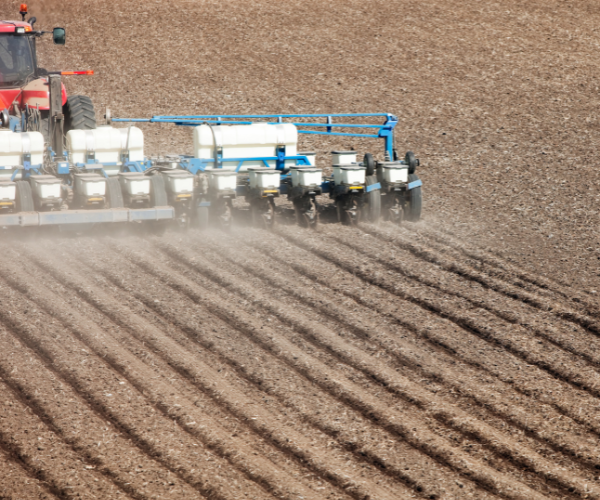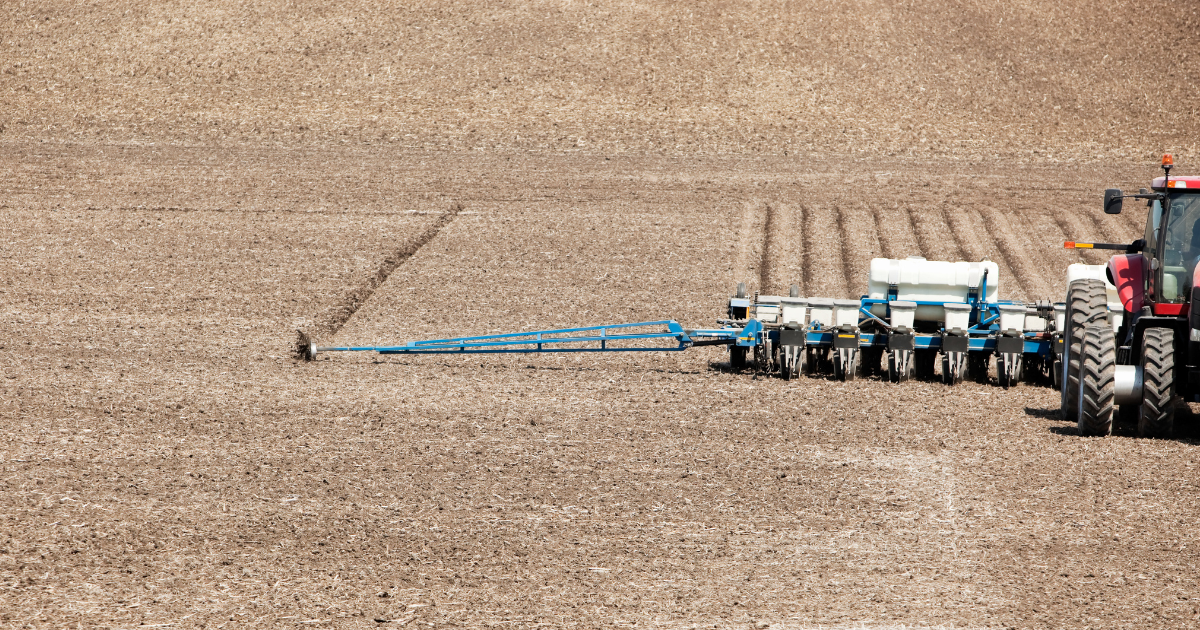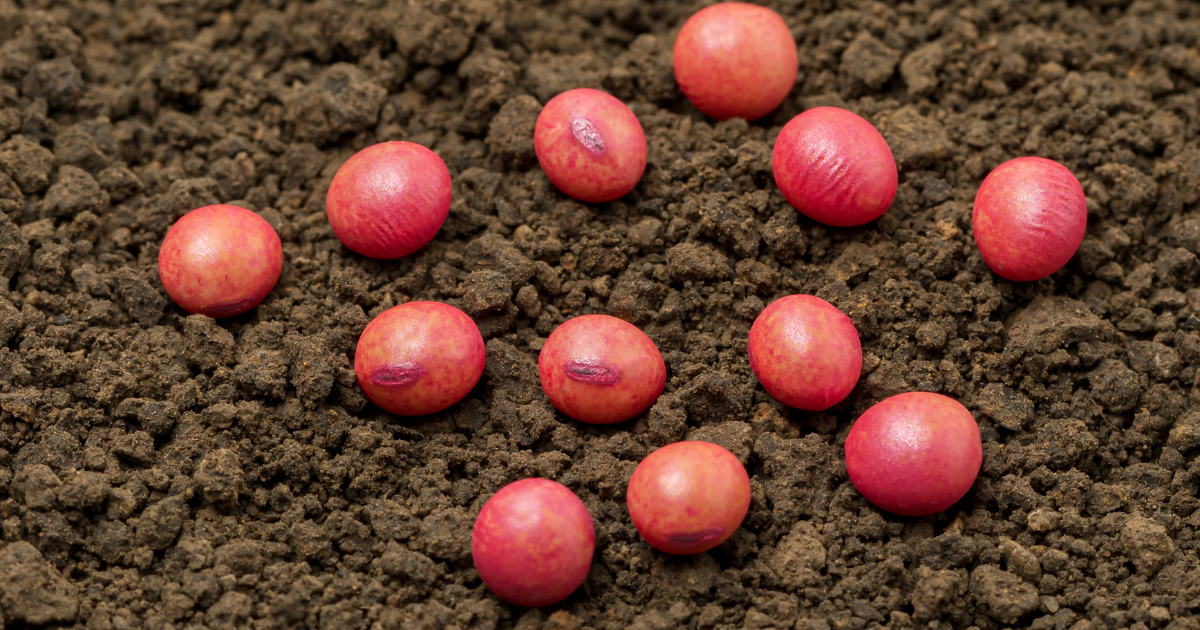
Seed-Placed Fertilizer & Seed Size Performance
Salt Index of Fertilizer Materials
| Material | Salt Index |
|---|---|
| Ammonium nitrate | 105 |
| Mono ammonium phosphate | 30 |
| Di ammonium phosphate | 34 |
| Urea | 75 |
| Triple superphosphate | 10 |
| Potassium chloride | 116 |
Source: Rader et al., 1943. Soil Sci. 55:201-218
The salt index of fertilizer has been defined as 100 times the ratio of the increase in soil-solution osmotic pressure produced by the material to the increase produced by the same weight of sodium nitrate2. In other words, the salt index is just a relative measure of the ability of a fertilizer material to remove moisture from its surroundings. The salt index for several fertilizer materials is shown in the table.
Soil moisture substantially influences the impact seed-placed fertilizer has on seeds and seedlings. Dry conditions at planting, with limited subsequent rainfall, greatly increase the potential for seedling damage. Planting into sandy soils, or other soils with limited moisture-holding capacity will also increase damage potential. In addition, crops vary in their response to seed-placed fertilizer at a given soil-moisture level. Relatively large amounts of plant nutrients can be banded near the seed (such as 2 inches to the side and 2 inches below the seed) with minimal negative effects.
GUIDELINES FOR SEED-PLACED FERTILIZER
CORN
Only 5 lb N/a as urea was enough to cause a substantial yield reduction in a Wisconsin study. Stand damage was not measured with ammonium nitrate until 20 lb N/a was applied. In a Nebraska trial, application of more than 10 lb/A. of N + potassium (as K2O) delayed germination and caused uneven emergence. In other Nebraska research, where the plots received adequate rainfall, N + K2O rates of up to 45 lb/a did not affect plant stand or yield. This emphasizes the significance soil moisture has on the effects of seed-placed fertilizer. Three years of Minnesota research using 5 to 15 gal/a of fluid fertilizers (4-10-10, 7-21-7, and 10-34-0) found no adverse effect on corn emergence or yield. Soil moisture levels at planting were relatively high each year. In South Dakota, triple superphosphate (TSP) and monoammonium phosphate (MAP) were found to be less injurious than diammonium phosphate (DAP). Free ammonia hydrolyzed from the DAP may explain this effect. To minimize the risk of stand reduction, the South Dakota researchers suggest not using DAP, UAN or urea with corn. They recommend not applying more than 10 lb/a of N + K2O and not more than 100 lb/a of material as 0-46-0, MAP, or 10-34-0 with the seed.
SOYBEANS
In our attempt to raise higher-yielding soybeans, some producers have incorporated the use of starter fertilizers in their production plan. Soybeans are less responsive to fertilizer applications, but more sensitive to seed-placed fertilizer than corn. Studies in Indiana found that soybean seed emergence was delayed and inhibited, regardless of the kind of fertilizer used, placement with or near the seed, soil type, or moisture content of the soil. Numerous studies have shown that soybean seed can be severely affected by seed-placed fertilizer. Many soil fertility specialists recommend not placing any fertilizer with soybean seed at planting. It has been suggested that if a narrow row spacing (7.5 inch) is used, small amounts of fertilizer (half the rate used for corn) could be used due to the reduced amount of fertilizer in direct contact with the soybean seed.
Seed placement of fertilizer directly on the seed is a management option that must be carried out with caution. Results will vary with the fertilizer source and soil-environment factors previously discussed. Desirable properties of seed-placed fertilizers would be low salt index, high analysis, and absence of NH3-liberating products such as urea and DAP. To minimize the risk of seedling injury and stand loss with seed-applied fertilizer: don’t apply any fertilizer directly with soybean seed and apply less than 10 lb/a of N + K2O with corn. For placement of larger quantities of nutrients below the soil surface, the traditional starter placement (2 inches below and to the side of the seed) or a deep-band placement should be used.
CORN SEED SIZE PERFORMANCE
As planting season approaches, questions on corn seed supply, corn seed size, and corn seed quality become quite common. Below are some from the past few weeks
Is there a difference in germination across corn seed size?
It depends. A study was conducted at the University of Wisconsin using small rounds, small flats, large rounds, and large flats of two hybrids with two tillage systems (no-till and conventional tillage) and two planting dates (early and late). Under early planting with no-till conditions, and with soil crusting, the emergence of small rounds ranged from 5 to 15% lower than that of small flats or large rounds. While the no-till system resulted in slower emergence that delayed early growth and silking, which resulted in reduced grain yield, seed size was irrelevant and did not have an impact on the final yield. In another study, under ideal conditions, seed size did not influence emergence; however, plants from small seed tended to have a short final height. Under stressful conditions, if planting small rounds, it may be advisable to increase the seeding rate to compensate for a possible reduction in emergence.
Does seed size influence seedling vigor?
Generally, vigor of seedlings from large flat kernels (from the middle of the ear) exceeds the vigor of seedlings from small (from ear tip) and large (from ear base) round kernels. Seedlings from larger seeds have higher weights and consequently larger seedlings. This is particularly important if planting is occurring at deeper than normal planting depths. While smaller seeds may have less vigorous plants in the vegetative stages, by the beginning of the reproductive stages the differences are negligible.
What are the advantages and disadvantages to corn seed size?
While larger seeds may have the advantage over small seeds under conditions of early planting in colder soil temperatures, smaller seeds can germinate faster in dry soils because less water is needed to initiate germination.
Does seed size impact final yield potential?
The research suggests that seed size does not impact final yield when plant populations are the same. Therefore, the most important aspect of obtaining the highest yield potential of a given corn product is achieving the optimal plant population for that product, not the seed size that is planted.
SOYBEAN SEED SIZE PERFORMANCE
This year soybean seed size is large. This is a product of the production year from 2014. Production fields that received ample amounts of moisture produced large seed. Much of the seed the Plattsmouth location has in the warehouse is around 2500 seeds/lb.
Does seed size impact soybean performance?
The first goal is to get a productive stand of plants established in the spring that can attain maximum crop yield potential in the fall. Concerns about stand establishment when planting small/large seed are generally unfounded. Many research trials have been conducted to determine if seed size affects soybean performance. Results indicate there is little relationship between seed size and percent emergence. While it is important to get a good stand of plants established to realize maximum crop yield potential, most research indicates that seed size has minimal impact on stand establishment.
Yield
The genetic potential of a small seed is the same as that of a large seed. Research trials suggest that seed size has little, if any, impact on yield. Because young seedlings of oilseed crops, such as soybeans, are related to the seed size, small seeds will produce slightly smaller seedlings than larger seeds. Once the plant has been established, yield potential depends on the genetic potential of the seed variety and growing conditions, regardless of seedling size.
Several multi-year studies have found no relationship between seed size and final yield. Research results indicate that seed size is not a crucial factor for successful soybean production.
Seed Quality vs Seed Size
Germination and seedling vigor is important when planting into cooler and usually wetter soils with early planting. G.E. Pepper, University of Illinois states, “When you are selecting soybean seed, seed quality should be a more important consideration than seed size.” Planting a seed lot with good germination and vigor scores will provide the best chance for satisfactory stand establishment, regardless of seed size. A soybean must absorb half its weight in water before germination begins. In field situations where soil moisture might be limited, a smaller seed might actually have an advantage over a larger seed, because it takes less total water to begin the germination process.
Dr. John MacNamara // Wilbur-Ellis Agronomist
SOURCES:
1Graven, L.M. and Carter, P.R. 1990. Seed size/shape and tillage system effect on corn growth and grain yield. Journal of Production, Agriculture. 3:445-452. https://pdfs.semanticscholar.org/0209/849f577d1734502cb0f2196a1286c7fa9288.pdf?_ga=2.203130001.1667694855.1582069379-166890626.1581509182
2Hunter, R.B. and Kannenberg, L.W. 1972. Effects of seed size on emergence, grain yield, and plant height in corn. Canadian Journal of Plant Science. 52:252-256. https://www.nrcresearchpress.com/doi/pdfplus/10.4141/cjps72-040
3El-Abady, M.I. 2015. Influence of maize seed size/shape, planted at different depths and temperatures on seed emergence and seedling vigor. Research Journal of Seed Science. 8:1-11. http://docsdrive.com/pdfs/academicjournals/rjss/2015/1-11.pdf
4Peterson, J.M., Perdomo, J.A., and Burris, J.S. 1995. Influence of kernel position, mechanical damage and controlled deterioration on estimates of hybrid maize seed quality. Seed Science and Technology. 23:647-657.
5<Elmore, R. and Abendroth, L. 2005. Do corn kernel size and shape matter? University of Nebraska Extension. https://digitalcommons.unl.edu/cgi/viewcontent.cgi?article=1290&context=cropwatch
6Chaudhry, A.U. and Ullah, M.I. 2001. Influence of seed size on yield, yield components and quality of three maize genotypes. Journal of Biological Sciences. 1: 150-151. https://scialert.net/abstract/?doi=jbs.2001.150.151



